Easy Yeast Rolls
Just a dozen easy yeast rolls? You got it. No more, no less, and all the easy steps you need to make light, airy rolls anytime you need them.

This recipe was originally published in March, 2014
Yeast rolls seem like they terrify way too many people. Are you one of them? Or maybe you’ve been searching for the softest, most flavorful easy yeast rolls that don’t make a blue ton or use 3 pounds of flour to put together.
You just need 12!
No matter what your situation, these easy yeast rolls will do it. This version is made by rolling two balls of dough about 2 inches in diameter and putting them side by side in a muffin tin to rise. That’s how you get the split down the middle. We called these butt rolls growing up. You can see why obviously.
If you don’t want to roll balls, just put them in the muffin tin in one larger ball or place them in a round cake pan barely touching–that’s another easy way to get your easy yeast rolls done with less fuss.
They’ll emerge from the oven so soft, warm and begging for a smear of butter and jam.
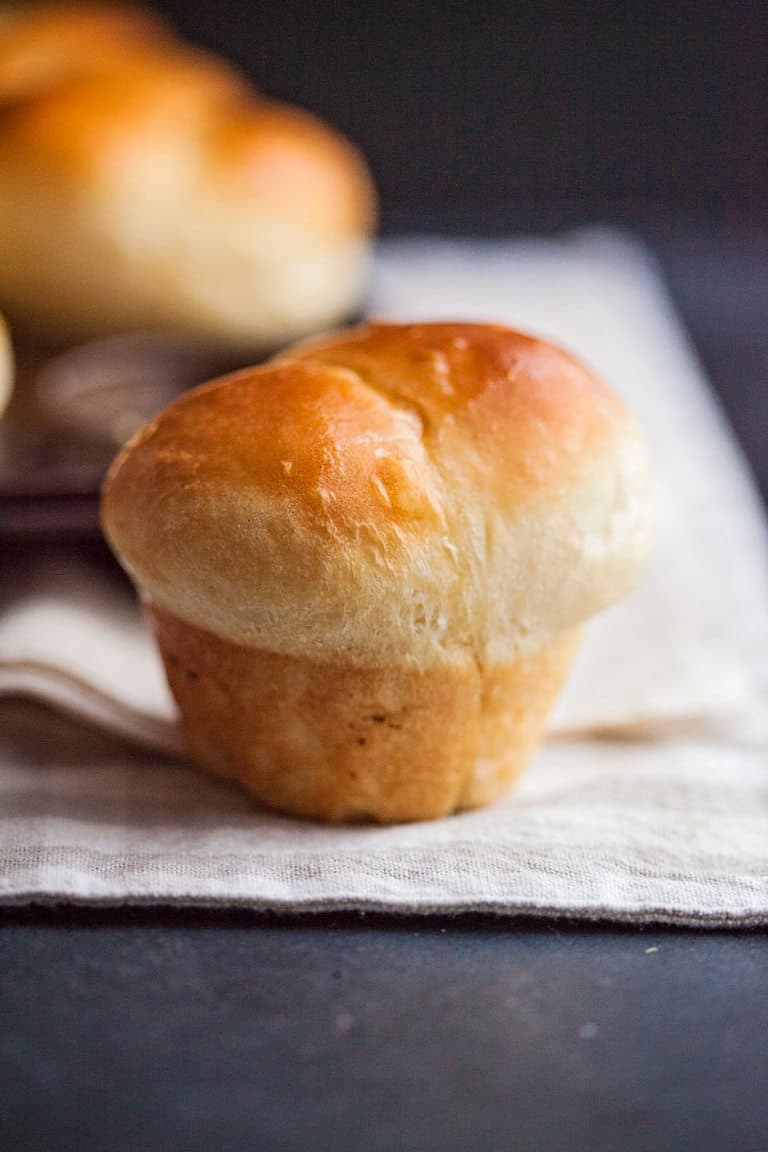
How to make these easy yeast rolls
- You’ll have to tackle yeast. Yes, I know. But you can do it. If you need some help, check out my post on how to activate yeast. It takes about 5 minutes. You can handle it. You can also watch me activate yeast on YouTube.
- Over the years I’ve tried a lot of flours–and a lot of brands of flours–to find one that works best. I actually find that the cheaper the flour is, the better it works, resulting in a lighter dough. If you want to use just all purpose flour, my favorites are King Arthur, Aldi’s flour or Hogsdon Mills from Walmart. I do not recommend Pillsbury or Gold Medal by any stretch.
- Bread flour is also excellent here and something that I really just started using in the last year and a half or so. I really like it here–it has more gluten in it and gives your dough more structure as it rises and I think the the yeast rolls are lighter. I like King Arthur for bread flour. You could also do half all purpose and half bread flour if you wanted to go that route.
- Avoid working too much flour into your dough when you knead it on the counter. A little stickiness won’t hurt anything. Keep your hands floured and avoid dumping it on the dough itself.
- If you want a stronger yeast flavor in your dough, let it rise in a cooler area for longer–the yeast will develop more fully and give you that signature flavor.
The difference between active dry yeast and instant yeast and how to swap them
There have been tons of questions about the difference is between active dry and instant yeast. This recipe calls for active dry yeast which needs to be activated in warm water before using it. I use active dry yeast because it was the standard type of yeast developed before instant and most time trusted recipes are written for that type–but one isn’t necessarily better or worse than the other.
Instant yeast can be activated in water OR it can be added dry right into the flour or dry ingredients and then added to your recipe. Instant yeast does not rise faster than active dry despite the “fast rise” on the package.
If you only have instant yeast on hand
If you only have instant/rapid rise yeast on hand, add the water (warm) that’s used in the recipe in with the eggs and oil. Then open the package of yeast and add it into the flour before adding it to the recipe and proceed as the recipe instructs.
Remember: Instant yeast can still fail
Just because you don’t have to activate instant yeast doesn’t mean it will just automatically rise. Your water must still be the correct temperature (luke warm) and your other ingredients needs to be room temperature as well. Too cold and the yeast still won’t wake up and leaven your rolls.
Not looking to work with yeast? Try my no-yeast quick rolls and give either version a big smear of my slow cooker apple butter.
How to develop a stronger yeast flavor
Yeast doughs develop flavor while they rise. The longer the rise, the more yeasty flavor that will develop. In order to do this, rise your dough in a cool location.
70-80 degree rooms will produce a doubled dough in 1 to 2 hours but to boost flavor, try moving your dough to a cooler part of your house or even a garage or closet that’s about 60 degrees until it doubles in size.
You can rise the dough in the refrigerator but only until it’s doubled–3 to 4 hours.
Can I rise the dough all night in the refrigerator?
Not in this case. I’ve tried it and the yeast amount is too aggressive for a long slow rise resulting in the digestion of all of the gluten in the flour. When morning comes you have a soup of sloppy dough you’ll have to throw out.
If you want to do an overnight or refrigerator roll, you’ll need a recipe written specifically for that process.
Watch me make these rolls on YouTube
Get instructions for this recipe as a loaf of bread here.
How to make these rolls ahead
Freeze them unbaked
The best way to make these ahead is to do the first rise, shape the dough, then freeze the dough balls on a cookie sheet or in the baking pan you want to bake in.
When you want to bake, remove from the freezer, place the dough balls in a greased muffin tin (if you didn’t freeze them in it) and cover with greased plastic wrap. Let the dough rise until doubled which will take 6 to 12 hours then bake.
Freeze them already baked
You can also bake the rolls and freeze them in an air tight container then wrap them in foil and reheat in a low oven for 10 to 12 minutes.
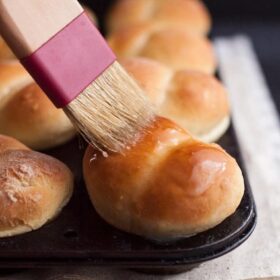
Homemade Yeast Rolls
Ingredients
- 1 cup water about 110 degrees or just slightly warmer than lukewarm
- 1 package active dry yeast *see note 1 for using instant yeast instead
- 3 tablespoons granulated sugar
- 2 tablespoons flavorless oil I prefer avocado but vegetable or canola also works
- 1 egg at room temperature
- 3/4 teaspoons salt
- 3-3 1/2 cups all purpose flour
Instructions
- In a large bowl, dissolve the yeast in the warm water.
- Add the sugar, oil, egg, salt, and half of the flour and mix until just combined.
- Add one more cup of flour and mix until the flour is combined again.
- Add between 1/2 of a cup to 1 whole cup of the remaining flour as needed until the dough comes together and is soft but not gooey. (Usually takes about 3/4 of a cup for me, but will depend on weather and humidity)
- Spray the top with cooking spray and cover with plastic wrap.
- Allow to rise in a warm place for one hour or until doubled.
- Turn dough out onto a floured surface and knead 4 or 5 times until the dough is slightly smooth.
- Spray muffin tin with cooking spray.
- Pinch off balls of dough about 1 1/2 inches in diameter and place two in each muffin tin side by side.
- Allow to rise about one hour more until doubled again.
- Bake at 400 for 12-15 minutes and brush melted butter over the tops when you take them out of the oven.

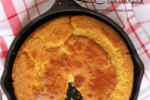



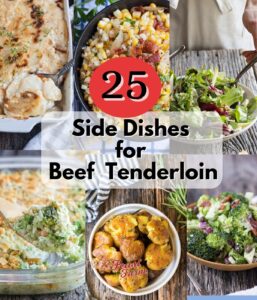

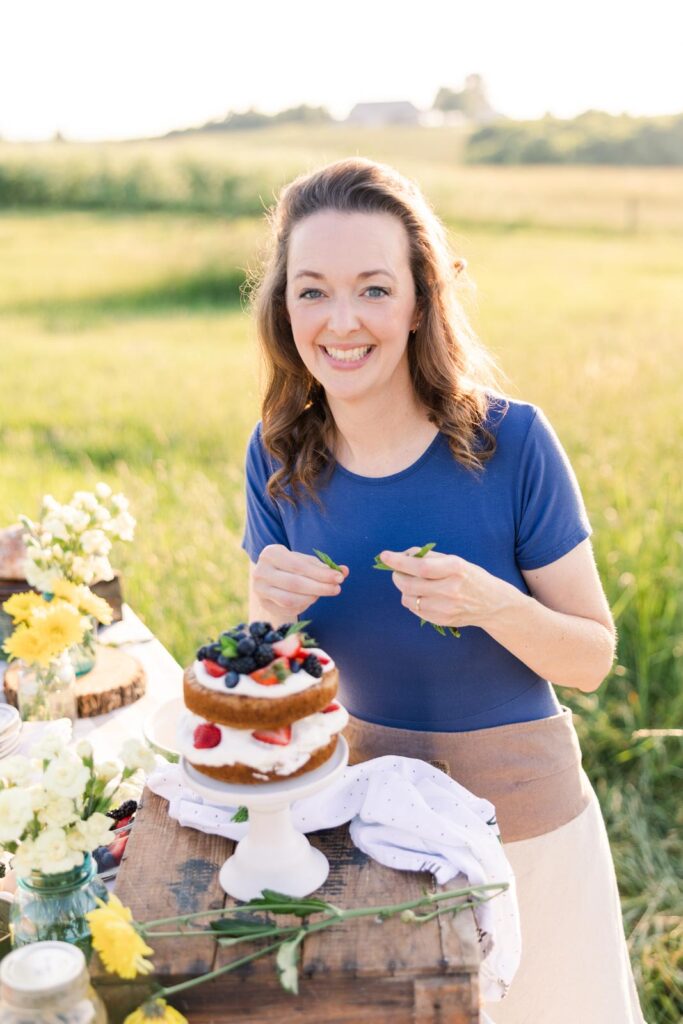
Wow, my “butt rolls” are huge! I think I could have easily made 15 or 18 instead of 12. They baked up beautifully and browned perfectly. They are soft and pillowy. I will definitely make again, only make them somewhat smaller. (I am so OCD that I weighed each ball of dough so they would be even.) My 4-star vs 5-star rating is due to the size and also, I think they need a little more salt for flavor. I do recommend!!! (I wish I could add a picture to show my beautiful, BIG rolls!)
Haha! Great job Linda! I think I compensate for the salt by using salted butter to spread on mine later. I think you’d be fine to bump it up 1/4 tsp if needed in your next batch. Size wise, I think the shape of your muffin pan makes a big difference. I have some wider, more narrow ones and some that are deeper like cones. The deeper one makes taller rolls because it’s skinnier. –Rachel
So, let me get this clear. To make so your rolls more yeasty, you have to let them rise longer. Is that correct? I have tried and tried to get that yeasty taste.
Hey Cindy, you want them to rise cooler for longer, yes. Yeast rises fastest between 70 and 80 degrees and the faster it rises, the less yeast flavor there will be. So if you can reduce the ambient temperature a bit the yeast will have time to develop more flavor. You can do this by putting the dough in a cooler part of your house if you have a space that’s around 60 degrees until the dough is doubled in size or you can use the refrigerator but only rise until the dough is doubled–3 to 4 hours at the most.
A lot of people ask if they can do an overnight rise but what happens there is that the yeast digests the flour too quickly and you’ll have a bowl of soup in the morning. Overnight rises require much less yeast in a recipe, and a recipe developed specifically for that. I hope that helps! –Rachel
I’ve tried letting the dough ball rise for 3 hours in about 65 degrees. After rolling in balls, I let them rise another hour. They rose but seemed to spread out as well. They are bland. Close but no cigar here. Any other tips?
Well let’s drill down on this then Cindy. My first question is what kind of bread are you used to eating? Frozen premade? Or homemade? I always ask because there are a lot of people who are so used to the additives in factory made food that when they make it at home they say it’s bland when the real issue is that the additives aren’t there and their brain physically misses those. So unless you’ve been a Sister Shubert addict up until now then that shouldn’t be the issue.
Next, what kind of salt are you using? If you have a large grain salt like Diamond Crystal, a large flake sea salt or kosher you’ll need more of that than a table salt because the grains are larger. I test all of my recipes with fine grain sea salt. If the dough feels truly bland that’s more of a salt issue than a yeast one I’d think.
And of course, you can let the dough sit longer if you want to. You won’t hurt them on the first rise to let the dough sit in the fridge for 4 or 5 hours.
As for the spreading, are you using a muffin tin and packing them in well? They will fill the tin but they shouldn’t be spreading. If you’d like to see a different lesson in how I shape these and put them in a 9×13, check out this recipe: https://feastandfarm.com/old-fashioned-yeast-rolls/ You’ll see how tightly they are fitted to the pan so there’s no room for things to spread anywhere they shouldn’t.
Beyond these ideas, I’m not sure how to help you find the flavor you’re after. I feel like the recipe solid as written. I hope you’re able to find a recipe that works for you.
–Rachel
Can I freeze this dough before baking it?
Hey Megan, you can shape rolls and place them in your baking pan then freeze. To bake, remove the pan and cover with greased plastic wrap. Let the dough sit until it thaws and rises–maybe 8 to 10 hours–then bake. –Rachel
Instead of using a muffin tin, could I use just a regular baking sheet and have them bake that way?
Yes Karim you can bake these in several ways. I’d recommend a baking dish with sides though–it will help the bread hold its shape better. –Rachel
My first attempt at yeast rolls and they came out ALMOST perfect. Not much of a yeast taste and needed more salt. The salt was my fault completely. Great recipe!
You can let the rolls do their first rise in the fridge for a while–three or four hours–to get a stronger yeast flavor if you want to Patrick. I’m glad you enjoyed them though! –Rachel
They worked! Yay. If I could show you a picture but I guess you can’t or I don’t know how to on your reply page.
Andrea you can tag me in photos on Instagram @feastandfarm, you can post photos on Pinterest with the pin, and you can email me if you’d like to as well! –Rachel
I have made rolls 4 times everytime they turn out heavy, I have tried a different recipe each time still heavy, I want a fluffy roll,how can I make that happen
Hey Dee, that’s a great question and a common problem. The truth about bread is that you usually have to make dozens of batches–maybe more than that before you really get a good handle on how to make them fluffy. Bread is a learned art and just takes practice. Assuming that your yeast is properly activated and that you have that part down, here are the most common reasons bread is heavy:
1) The wrong flour. Pillsbury, Gold Medal and White Lily make the worst bread I’ve ever eaten. I’ve found that King Arthur bread flour is my current favorite though I’ve had great success with Aldi all purpose, Hogsdon Mills from Walmart does well, and King Arthur all purpose is good.
2) Adding too much flour when kneading. This is the biggest problem usually. For my recipe here, I recommend measuring out 1/4 cup of flour and using only that to knead and shape your rolls. Adding 1/3 of a cup, or more (many people knead in a whole cup accidentally!) will make your bread hard and heavy.
3) Fiddling with the dough too much. Use a light touch when kneading and shaping balls of dough. Don’t fiddle with them for several minutes or treat them like play doh. This causes the gluten to build up further and makes them tough.
I have Youtube videos using this recipe to make a loaf of bread you can watch, plus posts here about how to properly knead dough (also using this recipe). I hope that helps and let me know if you have any other questions. –Rachel
I live in Mexico and I think that the yeast I have is instant and it is bulk so I have to measure it and I was wanting to know how much would I need?
Thank you for your instructive videos, I just found your vids tonight, watched a couple of them. I tried making bread earlier today but it was a flop more or less. Keep the narrow way that leads to life in Messiah by trust and obedience.
Hi Michael, You’ll need 2 1/4 teaspoons. Keep practicing!
Hello,
I noticed you do not recommend a couple of certain brands of flour😬 would it be terribly bad if I used one particular flour….at the moment that’s all I’ve got on hand😐
You’re welcome to use what you have. Just know that some flours just don’t make good bread. If you don’t love it or it’s very heavy after you bake it, try again another time with a different flour. –Rachel
Can I use freshly milled flour? Have you ever used it before?
Hey Maria, so freshly milled flour is whole wheat and this recipe (and all recipes for that matter) need to be written specifically for whole wheat in order to swap it here. You can exchange about half the flour in this recipe for whole wheat but the other half will still need to be all purpose or bread flour. I’d recommend finding a recipe written for 100% whole wheat flour if you want to use it exclusively. –Rachel